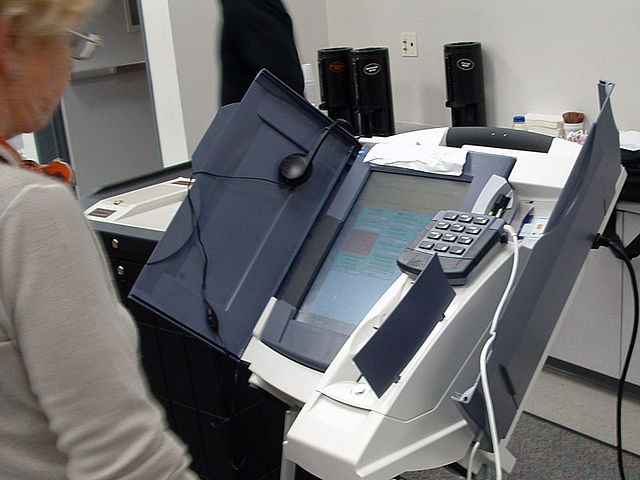Reprinted from columbusfreepress.com by Bob Fitrakis and Harvey Wasserman
Secretary of State Jon Husted:
Ohio has a long and unfortunate history of election irregularities. In recent years millions of Ohio citizens have been purged from the voter rolls. Large numbers of electronic voting machines have yielded dubious results that indicate manipulation and hacking.
In light of this, a number of serious issues have arisen surrounding this year's special election in the 12th Congressional District.
First, let us consider that Ohio, and U.S. elections in general, are undemocratic. They fail the basic tests of transparency by allowing private, partisan, for-profit companies to secretly program the computer voting machines.

Electronic Voting machine
(Image by (From Wikimedia) Original uploader was Joebeone at en.wikipedia, Author: Original uploader was Joebeone at en.wikipedia) Details Source DMCA
In all seven counties that comprise the 12th Congressional District in Ohio, easily hackable Direct-Recording Electronic (DRE) voting machines were used. Many of the counties used the notoriously rigged Diebold AccuVote TS touchscreen voting machines.
Former CIA Director James Woolsey co-wrote an editorial in the New York Times calling for the use of open source software in electronic voting machines and ending the use of DREs. A day prior to the 2016 presidential election, Woolsey told Fox News: "If I were a bad guy from another country who wanted to disrupt the American system"I think I'd concentrate on messing up the touch-screen systems."
The system of reporting the continuous vote count tallies on election night needs to be more transparent as well. As you recall, in 2015 there were numerous reports from election observers that the vote tallies were flipping on television news sites supplied by the county boards of elections.
Columbus Free Press election observers reported that during the continuous vote count reporting they were monitoring on the Ohio Secretary of State's website, they observed instances in which the number of precincts increased, but the vote count did not increase. Also, they noticed that vote counts would increase, but the number of precincts stayed static.
Also, we would advise you to change your stand on giving county boards of elections that have digital scanning voting machines the right to turn off their audit and ballot imaging systems.
Here in our state we continue to have many of the same problems revealed by former Ohio Secretary of State Jennifer Brunner in her seminal 2007 Everest study of electronic voting machine security, in which the majority machines proved vulnerable to manipulation.
Ohio needs to adopt new policy in regard to its post-Election audits, because of lack of transparency. There is no statutory guidance allowing observers to examine ballot marks. There is also no law that audit results and data be made public.
Again, the key principles are that open source software must be used to program every voting machine, every voting machine must have a paper ballot and a built-in security and audit system.
We have raised some of them in this memo. Your immediate public response would be greatly appreciated.
In light of the closeness of this week's special election and the number of provisional ballots that need to be carefully accounted for, we believe your response will receive very close national attention.
Thank you
Bob Fitrakis
Harvey Wasserman





